
Central Flying School (CFS) is a Royal Australian Air Force (RAAF) training unit, located at RAAF Base East Sale, Victoria. It operates the Pilatus PC-9 turboprop trainer. The school is responsible for training flight instructors, setting flying standards, and auditing flying practices. It is also home to the "Roulettes" aerobatic team. CFS was the first military aviation unit to be formed in Australia, in 1913, when its role was to provide basic flying training. Its current form dates from World War II, when it was re-established to train flying instructors for the Empire Air Training Scheme (EATS).
RAAF Station Cunderdin was a Royal Australian Air Force (RAAF) airfield located at Cunderdin, Western Australia, during World War II.
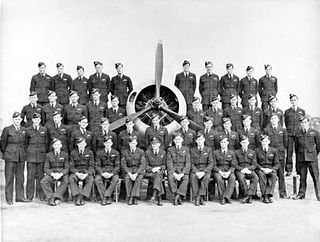
No. 5 Service Flying Training School was a Royal Australian Air Force (RAAF) flight training unit that operated during World War II. It was one of eight Service Flying Training Schools established by the RAAF to provide intermediate and advanced flying instruction to new pilots as part of Australia's contribution to the Empire Air Training Scheme. No. 5 SFTS was formed at RAAF Station Uranquinty, New South Wales, in October 1941, and disbanded in February 1946. Its staff and equipment were employed to re-establish No. 1 Flying Training School, which transferred to RAAF Station Point Cook, Victoria, the following year. Care and Maintenance Unit Uranquinty was also formed from No. 5 SFTS's facilities, to look after surplus aircraft at the base prior to their disposal, and disbanded in December 1948.

No. 4 Elementary Flying Training School was a Royal Australian Air Force (RAAF) pilot training unit that operated during World War II. It was one of twelve elementary flying training schools employed by the RAAF to provide introductory flight instruction to new pilots as part of Australia's contribution to the Empire Air Training Scheme. No. 4 EFTS was established in January 1940 at Mascot, New South Wales, and initially operated in conjunction with civilian flying organisations based at Mascot and Newcastle. The school was disbanded in April 1942, and its operations transferred to No. 6 Elementary Flying School at Tamworth.
RAAF Station Narromine was a Royal Australian Air Force (RAAF) station located at Narromine, New South Wales, Australia. Narromine Airfield was requisitioned in July 1940 as part of the Empire Air Training Scheme during the Second World War.

No. 5 Elementary Flying Training School was a Royal Australian Air Force (RAAF) pilot training unit that operated during World War II. It was one of twelve elementary flying training schools employed by the RAAF to provide introductory flight instruction to new pilots as part of Australia's contribution to the Empire Air Training Scheme. No. 5 EFTS was established in June 1940 at Narromine, New South Wales, and primarily operated Tiger Moths. It ceased training in June 1944, after more than 3,700 students had passed through.

No. 7 Service Flying Training School was a flying training school of the Royal Australian Air Force (RAAF) during World War II. It was formed in June 1941, and commenced flying the following month. Responsible for intermediate and advanced instruction of pilots under the Empire Air Training Scheme (EATS), the school was based at RAAF Station Deniliquin, New South Wales, and operated CAC Wirraway single-engined trainers. The Wirraways were classed as reserve aircraft for Australia's defence in response to the outbreak of the Pacific War in December 1941. Having graduated over 2,000 pilots, the school was renamed the Advanced Flying and Refresher Unit (AFRU) in December 1944. AFRU was disbanded in May 1946.
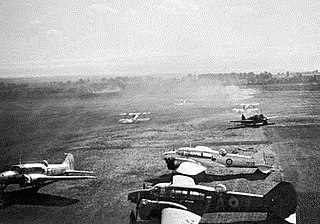
No. 2 Service Flying Training School was a flying training school of the Royal Australian Air Force (RAAF) that operated during World War II. It was formed in July 1940, under the command of Wing Commander Frederick Scherger. Responsible for intermediate and advanced instruction of pilots under the Empire Air Training Scheme (EATS), the school was based at RAAF Station Forest Hill near Wagga Wagga, New South Wales, and operated CAC Wirraway and Avro Anson aircraft. The Ansons were phased out in July 1941, and the school became an all-Wirraway unit. In 1942 the RAAF divided the personnel and equipment of No. 2 SFTS between Nos. 5 and 7 Service Flying Training Schools at Uranquinty and Deniliquin, respectively. No. 2 SFTS was disbanded that April, and the base facilities taken over by No. 5 Aircraft Depot.

No. 1 Initial Flying Training School was a flying training school of the Royal Australian Air Force (RAAF). It was formed in 1951 as No. 1 Initial Training School, in response to increased demand for aircrew during the Korean War and Malayan Emergency. Headquartered at RAAF Station Archerfield, Queensland, and operating de Havilland Tiger Moths, the unit was renamed No. 1 Initial Flying Training School in 1952. Ground staff from the school won the Hewitt Trophy for small arms proficiency in 1953. Aircrew training requirements eased following the end of the Korean War, and No. IFTS merged with No. 1 Basic Flying Training School at RAAF Base Uranquinty, New South Wales, in 1955.

No. 4 Service Flying Training School was a flying training school of the Royal Australian Air Force (RAAF) during World War II. It was formed in February 1941, and commenced flying the following month. Responsible for intermediate and advanced instruction of pilots under the Empire Air Training Scheme (EATS), the school was based at Geraldton, Western Australia, and operated Avro Anson aircraft. Two reserve squadrons were formed in response to the outbreak of war in the Pacific, though they never saw action. Flying activity was reduced towards the end of 1943, and the school was disbanded in May 1945, having graduated over 1,000 pilots. It re-formed as No. 87 Operational Base Unit, which was renamed Care and Maintenance Unit (CMU) Geraldton in May 1946. CMU Geraldton was disbanded in September 1947.
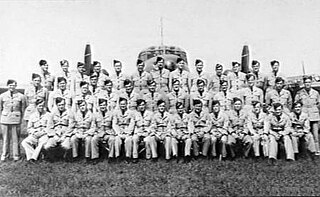
No. 3 Service Flying Training School was a flying training school of the Royal Australian Air Force (RAAF) during World War II. It was formed in September 1940, and commenced flying two months later. Responsible for intermediate and advanced instruction of pilots under the Empire Air Training Scheme (EATS), the school was based at RAAF Station Amberley, Queensland, and operated CAC Wirraway and Avro Anson aircraft. Two reserve squadrons were formed at the school in response to the outbreak of war in the Pacific, and the base fortified against air attack. In March 1942 the RAAF divided the staff and equipment of No. 3 SFTS between Nos. 1 and 6 Service Flying Training Schools at Point Cook, Victoria, and Mallala, South Australia, respectively. No. 3 SFTS was disbanded the following month.
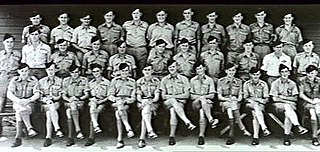
No. 6 Service Flying Training School was a flying training school of the Royal Australian Air Force (RAAF) during World War II. It was formed in August 1941, and commenced flying the following month. Responsible for intermediate and advanced instruction of pilots under the Empire Air Training Scheme (EATS), the school was based at RAAF Station Mallala, South Australia, and operated Avro Anson and Airspeed Oxford aircraft. The school formed a reserve squadron for Australia's defence after the outbreak of war in the Pacific in December 1941. Having graduated over 2,000 pilots, No. 6 SFTS completed its final training course in September 1945, and was re-formed as Care and Maintenance Unit Mallala in January 1946.
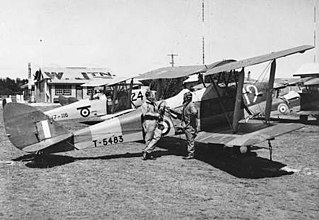
No. 7 Elementary Flying Training School was a Royal Australian Air Force (RAAF) pilot training unit that operated during World War II. It was established in August 1940 at Western Junction Aerodrome, Tasmania, and provided introductory flying training to new RAAF pilots. Training activities ceased in December 1944, and the unit was disbanded in August the next year.

No. 1 Elementary Flying Training School was a Royal Australian Air Force (RAAF) pilot training unit that operated during World War II. It was one of twelve elementary flying training schools employed by the RAAF to provide introductory flight instruction to new pilots as part of Australia's contribution to the Empire Air Training Scheme. The unit was established in November 1939 as No. 2 Flying Training School at Melbourne, Victoria. It was relocated to Parafield, South Australia, in December 1939 and renamed No. 1 EFTS the following month. Training activities relocated to Tamworth, New South Wales, in May 1944; the school was disbanded in December that year.

No. 8 Service Flying Training School was a flying training school of the Royal Australian Air Force (RAAF) that operated during World War II. It was formed in December 1941, and graduated its first course in March 1942. Responsible for intermediate and advanced instruction of pilots under the Empire Air Training Scheme (EATS), the school was based at RAAF Station Bundaberg, Queensland, and operated Avro Anson aircraft. It spawned two maritime patrol squadrons in early 1943, raised in response to increased Japanese submarine activity off Australia's east coast. Some of the school's aircraft were also attached to the Australian Army in 1944–45. No. 8 SFTS completed its final training course in December 1944, and was disbanded in July 1945.

No. 3 Elementary Flying Training School was a Royal Australian Air Force (RAAF) pilot training unit that operated during World War II. It was one of twelve elementary flying training schools employed by the RAAF to provide introductory flight instruction to new pilots as part of Australia's contribution to the Empire Air Training Scheme. No. 3 EFTS was established in January 1940 at Essendon, Victoria, and initially included a significant proportion of civilian staff and private aircraft; by mid-year these had been largely integrated into the military. The school was disbanded in May 1942, its aircraft and instructional staff having been transferred to No. 11 Elementary Flying School at Benalla.

No. 11 Elementary Flying Training School was a Royal Australian Air Force (RAAF) pilot training unit that operated during World War II. It was one of twelve elementary flying training schools employed by the RAAF to provide introductory flight instruction to new pilots as part of Australia's contribution to the Empire Air Training Scheme. No. 11 EFTS was established in June 1941 at Benalla, Victoria, and operated Tiger Moths and Wackett Trainers during the war. It ceased training in July 1945 after almost 3,000 students had passed through, and was re-formed as Care and Maintenance Unit (CMU) Benalla in February 1946. CMU Benalla was disbanded in October 1948.

No. 2 Elementary Flying Training School was a Royal Australian Air Force (RAAF) pilot training unit that operated during World War II. It was one of twelve elementary flying training schools employed by the RAAF to provide introductory flight instruction to new pilots as part of Australia's contribution to the Empire Air Training Scheme. No. 2 EFTS was established in November 1939 as No. 3 Flying Training School at Archerfield, Queensland, and partially utilised aircraft and facilities of the civilian air training organisations based there. The school was renamed No. 2 EFTS in January 1940. It was disbanded in March 1942, and its operations transferred to No. 5 Elementary Flying School at Narromine, New South Wales, and No. 11 Elementary Flying School at Benalla, Victoria.

No. 8 Elementary Flying Training School was a Royal Australian Air Force (RAAF) pilot training unit that operated during World War II. It was one of twelve elementary flying training schools employed by the RAAF to provide introductory flight instruction to new pilots as part of Australia's contribution to the Empire Air Training Scheme. No. 8 EFTS was established in September 1940 at Narrandera, New South Wales. Training ceased in December 1944 and the school was reduced to maintaining base infrastructure and aircraft. It was officially disbanded in June 1945 and renamed Care and Maintenance Unit (CMU) Narrandera. The CMU was disbanded in December 1947.

















